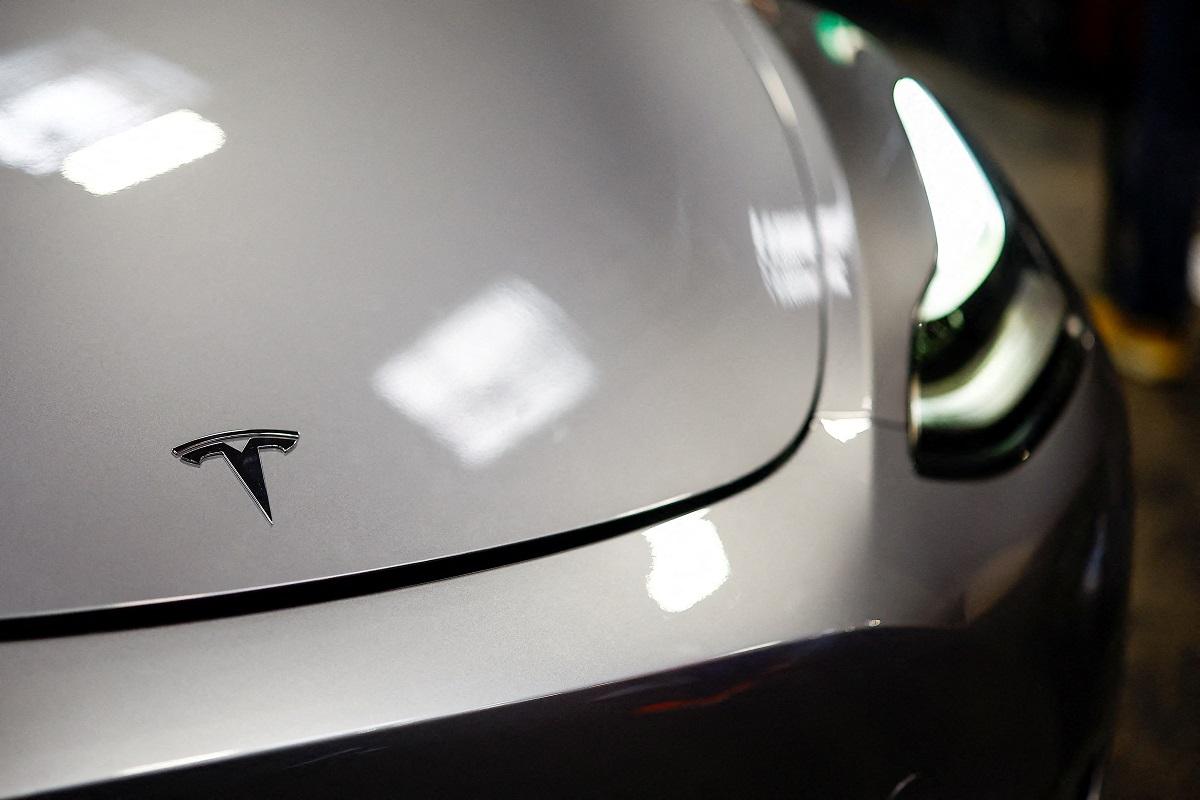GDP turns negative ...
low hiring numbers ...

but is this a buy-the-dip moment? ...
a rare indicator just went bullish ...
the MAGA 7 stocks ...
“blank sailings” soar This morning brought three big pieces of macro data: The GDP report The Personal Consumption Expenditures price index (PCE) The ADP jobs report Diving in, Q1 Gross Domestic Product (GDP) contracted 0.3%, down from 2.4% growth in Q4 of 2024.
This was the first negative GDP since early 2022. In its release, the Commerce Department wrote that the decline, “primarily reflected an increase in imports” and a “decrease in government spending.” Though President Trump’s tariffs kicked in after Q1, the increase in imports reflects companies trying to front-run Liberation-Day tariffs.
Legendary investor Louis Navellier zeroed in on this detail in this morning’s Growth Investor Flash Alert: There was a rush to import goods ahead of the tariff deadlines, as imports surged 41.3%, lowering growth by 4.8%.
In other words, if we back out the impact of the imports, growth was positive. So, the bottom line is I actually liked this report. Next up, PCE inflation gave investors a mixed bag.
On one hand, the headline month-to-month reading was flat – good news. Similarly, for “core” inflation, which strips out volatile food and energy prices, and is the Fed’s preferred inflation gauge, the number was also flat. Plus, this was below forecasts for a 0.
1% increase. Also, good news. However, year-over-year headline PCE inflation came in at 2.
3%, higher than the 2.1% forecast. Bad news.
Similarly, “core” PCE inflation rose 2.6% on the year, hotter than the forecast for a 2.5% increase.
Frankly, bulls and bears will cherry-pick data in the report to build their respective cases. The safer approach is to wait another month (or two) for clearer numbers reflecting how tariffs are impacting prices. Finally, the ADP jobs report found that the economy added only 62,000 private-sector jobs in April.
That’s down from 147,000 in March, and the smallest gain since last July. It’s also barely half of the Dow Jones forecast for 120,000. Altogether, the data reflect a nervous economy that’s unsure how to respond to today’s climate.
As to the stock market’s response, all three major indexes are down as I write, but they’re well off their lows of the morning. Pulling back, what are we to make of this morning’s economic data considering the market’s recent rally? Are today’s jitters a “buy the dip” moment within a wider continuation of that rally? Or is this a foretaste of a looming bear? So says market legend Warren Buffett. It makes sense.
Remove that “solvable problem” and the stock price roars back to where it previously traded – and potentially higher. Wouldn’t the logic equally apply to entire investment markets? It did with the S&P and its 2020 Covid flash crash..
. A great investment opportunity occurred when a marvelous stock market encountered a one-time, huge, but solvable pandemic. The result was a buying opportunity/rally for the ages.
.. Are we in the middle of another such buying opportunity? Coming into January, the market was overvalued, but it wasn’t trading at a “this bubble must burst immediately!” level.
And the economy was fundamentally strong. All the investment/economic damage suffered over the last two months has been self-inflicted..
.which means it can be self-corrected. According to our hypergrowth expert Luke Lango, that self-correction is coming.
And though the market has already begun pricing it in, the biggest gains remain ahead. When analyzing the market, Luke uses an arsenal of indicators, charts, moving averages, fundamental ratios – you name it – to help him forecast what’s coming. One especially powerful indicator he tracks is the Zweig Breadth Thrust (ZBT) indicator.
This indicator triggers when the percentage of advancing stocks on the NYSE (measured over a 10-day moving average) rises from below 40% to above 61.5% within 10 trading days. This rare surge in market breadth suggests that many stocks are suddenly moving higher, often marking the end of a bearish phase and the beginning of a major rally.
As you’re likely guessing, the Zweig Breadth Thrust indicator just triggered – last Thursday, to be exact. Here’s Luke with more details: The ZBT has only flashed 18 times since World War II. In every single instance, stocks were higher a year later — with average gains of 25%.
That’s not noise. That’s a signal. Meanwhile, the S&P 500 just last week notched three straight days of gains over 1.
5%. That’s another rare signal. Since 1950, every time that’s happened, stocks have been higher a year later — every single time — with average gains of 10%.
You don’t see this kind of price action in the middle of a collapse. You see it when a collapse is ending. We think stocks have bottomed — and we’re very bullish heading into the summer.
In yesterday’s Digest , we introduced Luke’s “MAGA 7” stocks. It’s a twist on President Trump’s “Make America Great Again” slogan, referring to..
. M ake A I G reat in A merica In this case, the “AI” refers to next-generation AI robotics that will power Trump’s efforts to revitalize the American manufacturing base. In yesterday’s Digest , we detailed why the onshoring effort won’t result in millions of new jobs for human workers.
In short, the numbers just don’t work. Instead, Corporate America will turn to AI. The outcome will be the accelerated adoption of robotics as businesses look for ways to cut input costs and blunt the impact of rising trade-related expenses.
This will be an enormous tailwind for a small group of stocks that find themselves in the middle of this economic shift – and that’s where Luke is hunting today: My MAGA 7 stocks are seven smaller AI companies — several of which you’ve likely never heard of — that are about to ride a wave of federal funding, corporate spending, and reshoring urgency into the spotlight. They’re building the tools. Laying the fiber.
Supplying the chips. Automating the factories. And powering the intelligence behind America’s next great tech renaissance.
For more on this basket of AI leaders, as well as the broader investment opportunity surrounding AI and robotics, Luke is holding his 2025 Summer Panic Summit tomorrow at 7 PM Eastern. Here, Luke explains why “panic” is the appropriate word to use: Investors are sitting on a record $7 trillion in cash, waiting for the opportunity to jump in. Private equity alone is sitting on at least $2.
62 trillion, according to S&P Global Market Intelligence. Though the ZBT Indicator says the surge starts now, a second, even bigger catalyst on May 7 could change the entire market and create a summer “panic” like we’ve not seen since 1997. Similar to how many naysayers of the early days of the Covid rally eventually realized they were late to the rebound and cannonballed into stocks, Luke believes we’ll see a similar dynamic play out in the coming weeks/months.
You’ll get all those details on Thursday. To join, clicking here will instantly sign up with an auto-registration. Circling back to Buffett and the idea of a one-time, huge, but solvable problem, here’s Luke with measured perspective: Volatility creates opportunity.
Every sell-off feels scary in the moment. But in hindsight, it always looks like a gift. This time will be no different.
Beneath the surface of the market chaos, the next great tech rally is forming. Here’s the one-click, instant sign-up link again. In yesterday’s Digest , we reported on the knife-edge drop in shipping traffic from China to U.
S. According to Vizion Global Ocean Bookings Tracker, China-to-U.S.
vessel traffic has fallen 22.2% over the last two weeks. On a year-over-year basis, it’s off 44%.
This is resulting in a sharp rise in “blank sailings” between China and the U.S. For more, Let’s go to maritime news website Splash 247 : Blank sailings occur when ocean carriers skip scheduled port calls due to low freight demand or equipment shortages, disrupting supply chains.
In April 2025, over 80 blank sailings were reported, surpassing the 51 from May 2020, signaling a severe collapse in global shipping activity...
The Sea-Intelligence Blank Sailings Tracker measures, on a weekly basis, the number of planned sailings which are blanked for the coming 12 weeks, as well as the capacity taking out due to this blanking. The latest data from Sea-Intelligence, described as “staggering” in a weekly report published yesterday, shows that carriers anticipate container demand for week 18, next week, on the Asia to US west coast trade lane will be 28% lower than expected, while for week 19, carriers are expecting shippers to move as much as 42% less cargo than anticipated on the Asia to US east coast trade lane. Now, this doesn’t mean it’s time to race to the supermarket and stock up on toilet paper (over 99% of toilet paper used in the U.
S. is domestically produced). But unless something changes, supplies of toys, apparel, and furniture could be sparse in the coming weeks.
Here’s Investopedia from yesterday: If traffic remains depressed, Americans may soon contend with shortages of items commonly sourced from China, which could push prices higher, [Torsten Sløk, Apollo Global Management’s chief economist] said. Ongoing and fast-evolving trade policies could have a particularly dramatic impact on toys, apparel and furniture. Some $41 billion in toys, games and sports equipment was imported in 2024, and merchandise from China accounted for more than 70% of that, according to data from the Department of Commerce.
Remember, if we learned one thing with Covid, it’s that supply chains turn off quickly, but can take months to restart. So, beyond the immediate economic hit, the longer this trade war drags on, the greater the risk that shortages extend into the back-to-school and holiday shopping seasons. All the investment/economic damage suffered over the last two months has been self-inflicted.
..which means it can be self-corrected.
Just one social media post from President Trump will begin cleaning up all this mess, and will send the market exploding higher. After all..
. A great investment opportunity occurs when a marvelous stock market encounters a one-time, huge, but solvable trade war. That’s what we’re hoping for.
..and it’s what Luke is positioning his readers for.
Have a good evening, Jeff Remsburg.
Business

Data Show a Cooling Economy

InvestorPlace - Stock Market News, Stock Advice & Trading TipsGDP turns negative ... low hiring numbers ... but is this a buy-the-dip moment? ... a rare indicator just went bullish ... the MAGA 7 stocks ... “blank sailings” soar This morning brought three big pieces of macro data: The GDP report The Personal Consumption Expenditures price index (PCE) The ADP jobs report Diving in,...The post Data Show a Cooling Economy appeared first on InvestorPlace.














